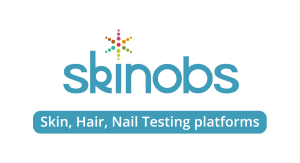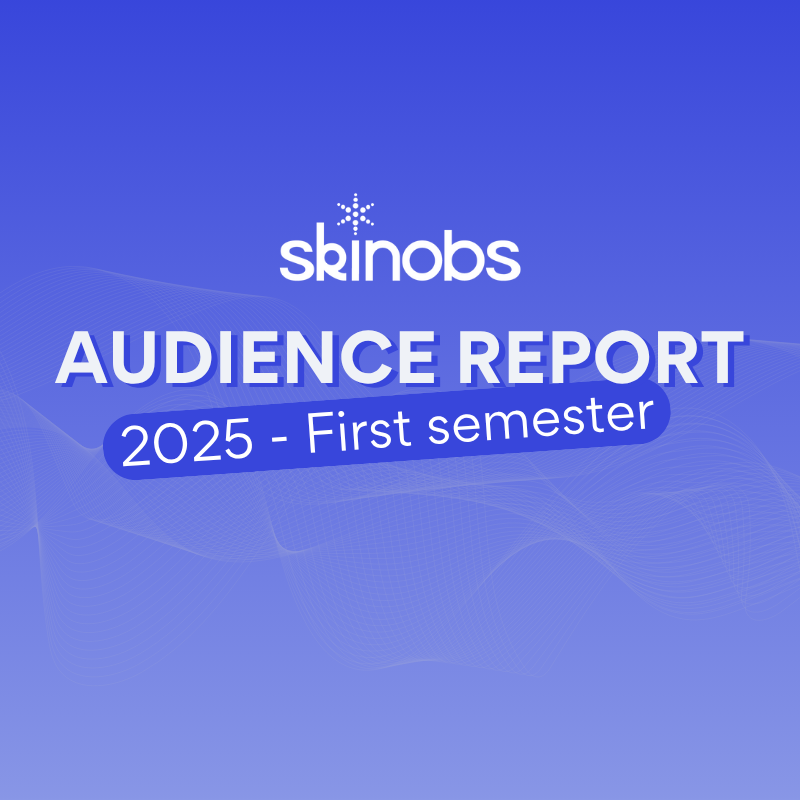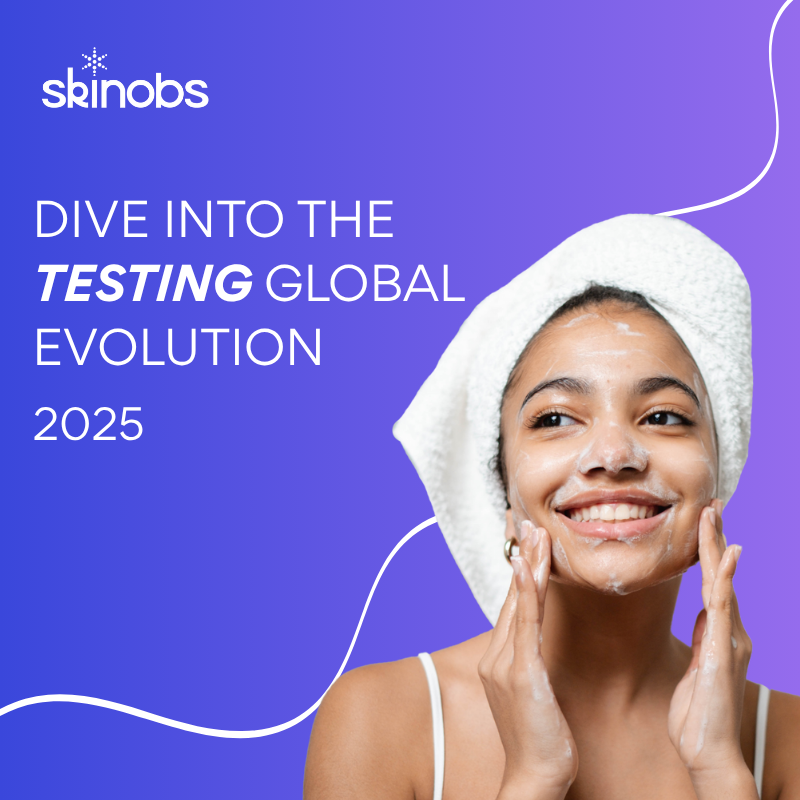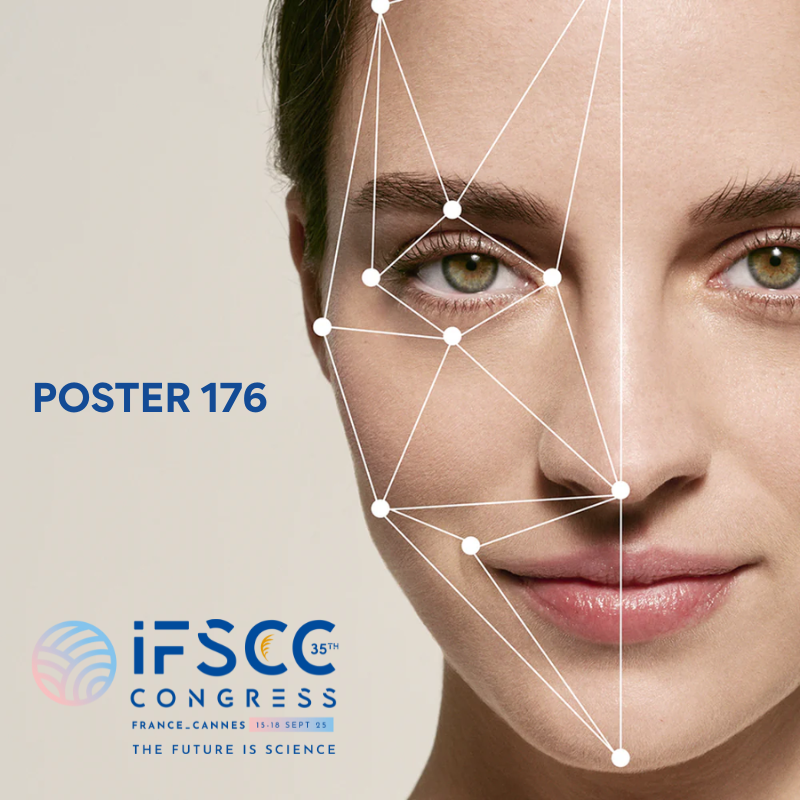Today, we are sharing an overview of Skinobs’ study of the European market for the clinical evaluation of skincare ingredients and brands carried out in 2022. This market concerns more specifically the analysis of skin, hair, scalp and nails, and the study of safety, tolerance and efficacy. These in-vivo human evaluation services are organized around biometrological studies and measurements, consumer tests and sensory and neurosensory analysis.
To summarize the technological and economic information concerning this market dedicated to the beauty industry, we conducted a study in 2022 based on 3 axes:
– a quantitative survey of the purchasing habits of evaluation managers;
– an in-depth analysis of the methods and tests available worldwide and specifically in Europe.
– a quantitative study of the value of this market.
The innovative and resilient beauty market
Representing €228 billion in 2021, the global beauty industry is dynamic and resilient, facing major challenges in a variety of territories such as China, where consumer expectations are becoming increasingly complex: inclusiveness, social and environmental responsibility, performance… The leading category in this sector is skincare, with a 42% market share. At the same time, cosmetics manufacturers are faced with accelerating changes in consumer trends, which tends to reduce the time devoted to the product evaluation phase. In this competitive environment, innovation is fundamental to the various phases of development, particularly in the field of testing, the link between product performance and scientific communication. Four main trends are having a lasting influence on the beauty market: cultural change, social and environmental responsibility, regulation and digital technology. New digital technologies such as connected objects, artificial intelligence, virtual reality and diagnostic applications are playing a key role in the beauty market. Diagnostic applications are playing a major role the industry’s entire value chain of this industry. Clinical trials must meet and anticipate all these expectations.
Expectations of clinical evaluation managers
Among the European respondents, R&D or evaluation managers, cosmetics or active ingredients brands or manufacturers, most work with five or more testing laboratories. Most of them are based in France and Europe, but some are also based in North America and China. The main criterion for laboratory selection is expertise. When sourcing new test laboratories, the clinical experts mainly use their business contacts, but also the Skinobs Platforms. These managers select their service providers based on several criteria, mainly depending on the claim to be studied, the cost of the studies, the measuring equipment available to visualize and/or quantify product performance and, finally, the type of subject. The top 3 claims for which experts spend the most time looking for a test are: anti-ageing, moisturizing and sensitive skin claims. For the clinical trials sector, it appears that those responsible for evaluating brands of active ingredients and cosmetic products have a real power to influence the sector. Because of the diversity of the companies that make up the beauty industry nowadays, in terms of size, expertise, location and core business, test managers have a wide range of technical, regulatory and marketing expectations. They influence the market in their choice of measurement technologies, protocols and subcontracting laboratories. Among the experts who responded to the survey, 88% find the Skinobs Platforms very useful, while 86% read the Skinobs NewsFeed. French respondents are mainly delighted to find the list of methods and the detailed description of the methods they can consult on the platform. English respondents mainly appreciate the possibility of finding new testing laboratories and new technologies on Skinobs.
Europe remains a historic leader for clinical trial laboratories
We share with you a global overview of the world’s clinical expertise dedicated to the beauty industry. Europe is the main testing partner. The second most important location for these types of services is Asia, followed by North America. Africa and South America each account for only a small percentage. It should be noted that a large proportion of testing laboratories have a single centre, while only a few have more than five centres. The latter represent international groups such as Mérieux Nutrisciences, Eurofins, Ms Research, Cliantha Research, MMR research and SGs, which offer testing solutions throughout the world. These include European laboratories such as IEC Group, Complife Group and CIDP, which have developed their tolerance and efficacy testing activities on several continents. In Europe, the presence of testing laboratories is influenced by the importance of the beauty sector in each country and its historical position since the 20th century. There are several reasons why France and Europe are leaders in this field:
– the dynamism of the Beauty sector, with the presence of the undisputed leader in Beauty, L’Oréal, and many other historic companies such as Coty, Yves Rocher, Unilever, P&G, Henkel, Beiersdorf, Puig… and a myriad of medium-sized companies such as Clarins, Nuxe, Caudalie…;
– competition between these brands, which requires a high level of scientific evaluation of safety and performance;
– the presence of most of the instrumentation manufacturers, who provide innovative technologies and solutions.
Over the last ten years, the Iberian Peninsula, Spain and Portugal have seen a dynamic increase in the number of tests offered by suppliers. This territory offers a wide range of tests for skin, hair or nails, with an increasingly sophisticated high-tech approach implementing studies with cutting-edge instrumentation including data processing with i.A. There are more than 18 Spanish and Portuguese test laboratories in Europe out of a total of 130 laboratories, which represents 14% of the total number of laboratories. The clinical testing market is mature in European countries, and most of the specialist laboratories were founded in the 1990s. With their senior management reaching retirement age, many laboratories have been sold to secure their future development, such as proderm, Idea, Evic, Alba Science, Spincontrol and Bio-EC. The French Crops (Spincontrol, Dermscan, IEC Group, Idea, Cosderma, etc.) and the Mauritian Crops (CIDP), which began operating in France in the 1990s, rapidly expanded their operations to other countries such as Korea, Japan, Thailand, Brazil, India, China, South Africa and Canada, in response to the need for multi-centre studies on various ethnic groups, specific regulations (Japan, Korea, China) and the demand for cost reduction. demand for cost reduction.
Tests and methods, a wide range of services
With over 300 methods, Europe offers the greatest variety, while Asia and North America come next with 224 and 185 methods respectively. If we look specifically at France, we can count over 250 methods available for assessing tolerance and efficacy. We can see that classic methods such as the Corneometer (Courage + Khazaka) are used by a large majority of laboratories on all five continents. In contrast, high-tech instruments such as the ColorFace (Newtone Technologies), Antera 3D (Miravex), Vivosight or AEVA (Eotech) are used by a small number of test laboratories. There are only around 20 tolerance methods because of their standardised protocols. The same applies to consumer tests and sensory analysis, with few different methods. Over the last 20 years, there has been continuous development of biometrological tests for nails, skin and hair. The high technological level of these methods. Finally, hair care methods represent specific, innovative and a very dynamic field of study. Methods for assessing skin hydration or the biometric properties biometrological properties of the face and wrinkles.
Ever more technology in clinical evaluation
When it comes to biometrological measuring devices, Europe is also the leader, with 66 companies on the continent supplying specific and varied instruments for analyzing the performance of skin, scalp, hair or nails, personal care products, toiletries, make-up or sun care products. Naturally, the protocols that follow trends in claims are those that offer the most technological innovation. Those responsible for clinical evaluation know that they can count on testing laboratories around the world to offer them new methods of analysis such as quantification and visualization of the skin or hair, nomadic tools with increasingly widespread use of AI. If we look at the breakdown of equipment manufacturers, the same trends emerge. Europe leads the way, followed by Asia and North America.
This is undoubtedly due to Europe’s leadership in the cosmetics industry, particularly in France since the nineteenth century. The dynamism of this sector is stimulating the development of new technologies in France and Germany. For example, Courage and Khazaka, Newtone, Miravex, Eotech and Orion Technolab distribute their measuring equipment worldwide. In addition, we can see that the most studied claims are those that represent the essence of skincare products, such as hydration and anti-ageing, and where there is the most innovation. A good example of this is the study of biomechanical properties, the structure of the skin or the collagen network, with the recent appearance of new equipment used in routine studies. Even if expert scoring is very popular, it is also the protocols with instrumental measurements that offer the greatest variety of tests, since consumer tests are standardised and sensory analysis is also standardised.
A competitive and attractive market
The clinical evaluation environment for the beauty industry is not as competitive for tests with a high technological value requiring a high level of expertise (hair care, innovative methods) and sun tests. In these cases, the bargaining power of cosmetics brands is weaker, and there is no threat of substitution. For more standardized tests (traditional methods, tolerance tests, etc.), supply is generally lower than global demand. The negotiating power of testing laboratories is significant, and time management is crucial, even if budgets are often fiercely debated. In addition, clinical evaluation includes consumer tests, which account for the vast majority of in-vivo studies worldwide, in response to the need for inclusiveness (multicenter studies), the need for a consumer approach and the need to comply with regulations in each region of the world. Specifically for the in vivo evaluation of suncare products, demand for tests is much higher than supply. The determination of the SPF index (UVB), UVA-PF, which follow specific guidelines, and blue-light and infrared require special know-how, and brands around the world are looking for ever shorter turnaround times for results. The greatest threats of substitution on clinical and biometrological tests are the development and democratization of in-vitro studies using cell cultures, models or skin explants. There is also a trend towards adapting in-vivo measurement methods to in-vitro and ex-vivo tests. These preclinical quantification or visualization studies offer an ethically interesting and agile alternative, with flexibility in the number of tests, positive references and customized test conditions. Furthermore, with the advent of artificial intelligence for data processing, it is conceivable that one day efficacy results could be obtained in silico via algorithms, as is already the case for certain toxicity and safety tests. Public authorities also have a major influence on the regulation of cosmetics and their evaluation. The regulations imposed by various governments now constitute a real barrier to the entry of brands into their markets. China is the most recent example. Established international laboratories need approval of their testing process from the authorities. This barrier to entry has an impact on the testing industry. In addition, tensions in Sino American relations can sometimes affect the commercial relations of instrumentation manufacturers and testing laboratories. Finally, we can say that the European competitive context of the clinical evaluation sector is dynamic and homogeneous in terms of the different criteria that influence it. There are no major dangers that could affect its good health. However, it is necessary to keep a close eye on two elements: regulatory developments in specific regions and, secondly, the power of the largest test groups which, through their external acquisitions, are resizing the market worldwide. It is clear that Europe is the leader in terms of the supply of cosmetic clinical tests. This continent holds a solid leadership position in the market, but as we saw in the very first part, the Asian market has been a major player for many years. Asian market has been a major player for many years, particularly Korea and Japan. With China’s new era of economic development in this area, we can consider that it will be the next centre of activity in this sector in the coming decades.
Conclusion
In this study, we have looked at what might be the perfect marketing positioning for a testing laboratory when it comes to pricing, advertising, communication, business development, management, process and proof. We have taken into account all the macro and micro trends and developments to define the dynamics and future challenges of this very specific market and to define the competitive advantages needed by the players in this sector. To conclude this article, we can say that by conducting this unique study on clinical trial services dedicated to the beauty industry, we have confirmed the vitality of this sector with a high level of expertise.
CONTACT
Anne Charpentier
acharpentier@skinobs.com






